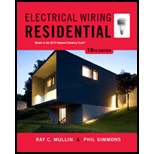
Electrical Wiring Residential
18th Edition
ISBN: 9781285170954
Author: Ray C. Mullin, Phil Simmons
Publisher: Cengage Learning
expand_more
expand_more
format_list_bulleted
Concept explainers
Question
Chapter 27, Problem 31R
To determine
Choose the correct option from the given options to confirm a complete grounding electrode system.
Expert Solution & Answer
Trending nowThis is a popular solution!

Students have asked these similar questions
Look up the dislocation-induced energy levels in silicon and GaAs - cite your sources.
a. Sketch them in the band gap.
b. When are each of them most active?
c. Are dislocations more detrimental in Si or GaAs?
d. What is the threshold of dislocation density that each semiconductor can
handle?
Q1: In a material for which o 9 s/m and e, -4, the electric field intensity E = 50 sin 8*10'1
V/m. Find:
a. The conduction and displacement current densities.
b. The frequency at which the conduction current is half the displacement current.
Q2: The circular loop conductor lies in the Z-0 plane, has a radius of 40 cm and a resistance
of 40 Q. Given B-0.9 sin 5°10' ta, Determine
a. The induced voltage
b. Current
Chapter 27 Solutions
Electrical Wiring Residential
Ch. 27 - Define the Service Point. ______________Ch. 27 - Define service-drop conductors.Ch. 27 - Prob. 3RCh. 27 - a. The service head must be located (above)...Ch. 27 - Prob. 5RCh. 27 - When a conduit is extended through a roof, must it...Ch. 27 - a. What size and type of conductors are installed...Ch. 27 - How and where is the grounding electrode conductor...Ch. 27 - What are the minimum distances or clearances for...Ch. 27 - What are the minimum size ungrounded conductors...
Ch. 27 - What is the minimum size copper grounding...Ch. 27 - What is the recommended height of a meter socket...Ch. 27 - Prob. 13RCh. 27 - Prob. 14RCh. 27 - Prob. 15RCh. 27 - Prob. 16RCh. 27 - Prob. 17RCh. 27 - Prob. 18RCh. 27 - Prob. 19RCh. 27 - Prob. 20RCh. 27 - Prob. 21RCh. 27 - Prob. 22RCh. 27 - Prob. 23RCh. 27 - Prob. 24RCh. 27 - Prob. 25RCh. 27 - Prob. 26RCh. 27 - Prob. 27RCh. 27 - Prob. 28RCh. 27 - Prob. 29RCh. 27 - Prob. 30RCh. 27 - Prob. 31RCh. 27 - Prob. 32RCh. 27 - Prob. 33RCh. 27 - Prob. 34RCh. 27 - Prob. 35RCh. 27 - Prob. 36RCh. 27 - Prob. 37RCh. 27 - Prob. 38RCh. 27 - Prob. 39RCh. 27 - Prob. 40RCh. 27 - Prob. 42RCh. 27 - Prob. 43RCh. 27 - Prob. 44RCh. 27 - Prob. 45RCh. 27 - Prob. 46RCh. 27 - Prob. 47RCh. 27 - Prob. 48R
Knowledge Booster
Learn more about
Need a deep-dive on the concept behind this application? Look no further. Learn more about this topic, electrical-engineering and related others by exploring similar questions and additional content below.Similar questions
- Find the direction at which the directional derivative of f(x,y) = x² + sin(xy) at (1.0) has the value of 1.arrow_forwardUsing the table below, design a third (3th) order Butterworth HPF with a 4 KHz cutoff frequency. What is the additional stage required to HPF to design a third order BPF. Explain your answe Order Stage poles DF 2 stage poles 3 stage DF poles DF 1 1 Optional 2 1.414 3 י 1 1 2 1.848 2 0.765 5 2 1 1.618 1 0.618 6 2 1.932 1.414 2 0.518arrow_forward.I need the correct answer, and if it's wrong, please fix it 7. The midrange voltage gain of an amplifier is 100. The input RC circuit has a lower critical frequency of 1 kHz. The actual voltage gain at f-100 Hz is 100. 10. In a high-pass filter, the roll-off region occurs above the critical frequency.arrow_forward
- Q3/A unity-feedback system with the forward transfer function G(S)= K S(S+7) is operating with a closed-loop step response that has 15% overshoot. Do the following: a. Evaluate the steady-state error for a unit ramp input. b. Design a lag compensator to improve the steady-state error by a factor of 20 to get a new dominant closed-loop poles S-3.4+ j5.63. place the pole of the lag compensator at s=-0.01 c. Design a lag compensator using OP amp if R1= 100KS2 R2=10 KS2 and R3= 10Karrow_forwardQ2: (33 Marks) Design FBD for manufacturing system where a conveyor belt is used to move a cart through a tunnel for processing. The process begins when a worker presses a start push button located at the start of the conveyor. Once the start push button is pressed, the cart moves forward along the conveyor belt and enters the tunnel. When the cart reaches the end of the tunnel, it stops automatically and remains in place for 10-minutes to complete a required operation, such as cooling or drying. After the 10-minute delay, the cart automatically returns to the starting point where the worker is stationed. The system then waits for the worker to press the start push button again, at which point the process is repeated. Start PBO Stop PBO LSI 0 LS 2 Motorarrow_forward1. Find the resolution, current and output voltage for a binary weighted resistor DAC of (applied binary word is (locoj), the resistor values R = 12 kQ, Rf = 6 k2 and VR = 12 V. 2. Convert the following 5-bit digital values (ble 10) to analog, using the R-2R ladder. Assume that the Vs = 10 V, R = Rf = 7 ksarrow_forward
arrow_back_ios
SEE MORE QUESTIONS
arrow_forward_ios
Recommended textbooks for you
 EBK ELECTRICAL WIRING RESIDENTIALElectrical EngineeringISBN:9781337516549Author:SimmonsPublisher:CENGAGE LEARNING - CONSIGNMENT
EBK ELECTRICAL WIRING RESIDENTIALElectrical EngineeringISBN:9781337516549Author:SimmonsPublisher:CENGAGE LEARNING - CONSIGNMENT

EBK ELECTRICAL WIRING RESIDENTIAL
Electrical Engineering
ISBN:9781337516549
Author:Simmons
Publisher:CENGAGE LEARNING - CONSIGNMENT
What is an electric furnace and how does it work?; Author: Fire & Ice Heating and Air Conditioning Inc;https://www.youtube.com/watch?v=wjAWecPGi0M;License: Standard Youtube License